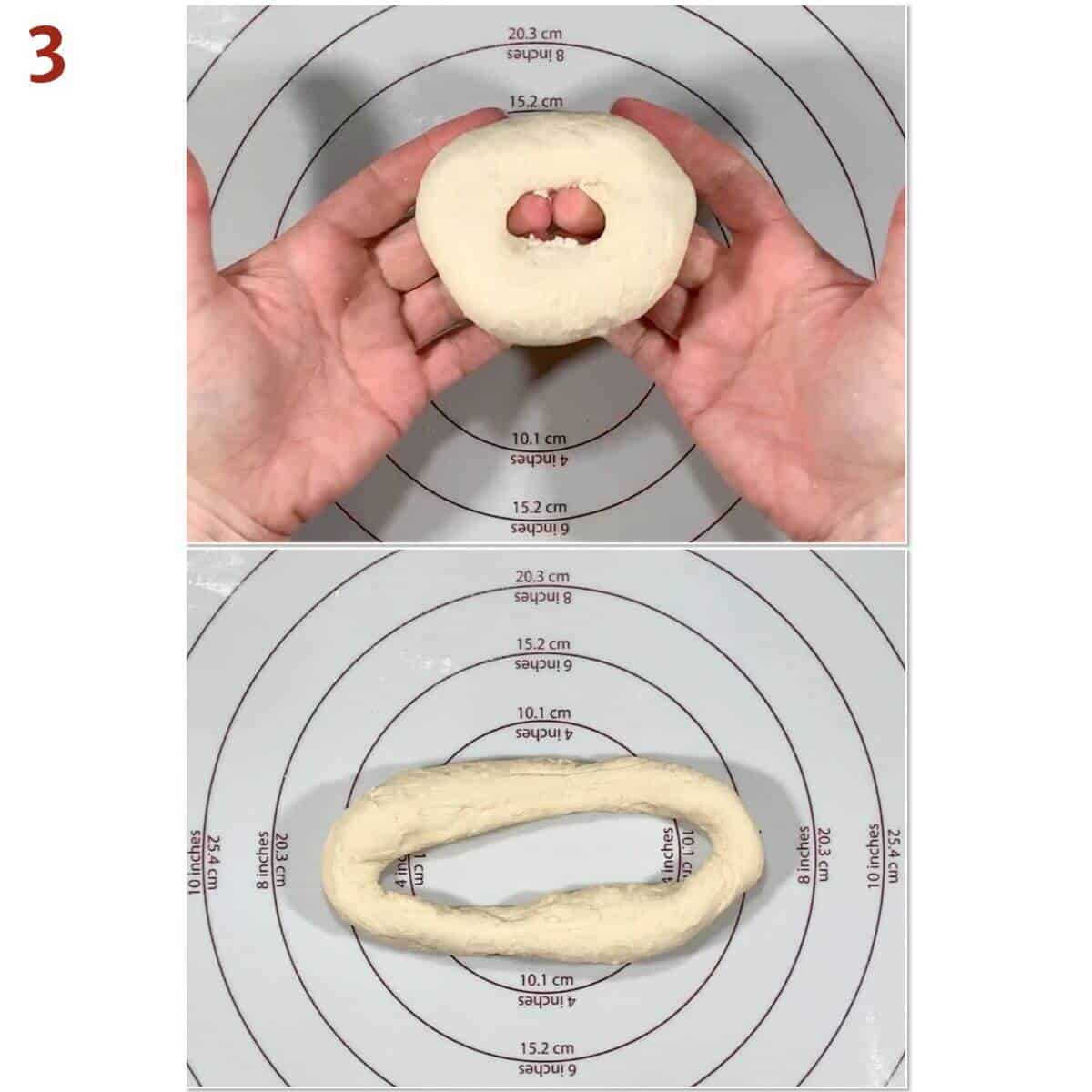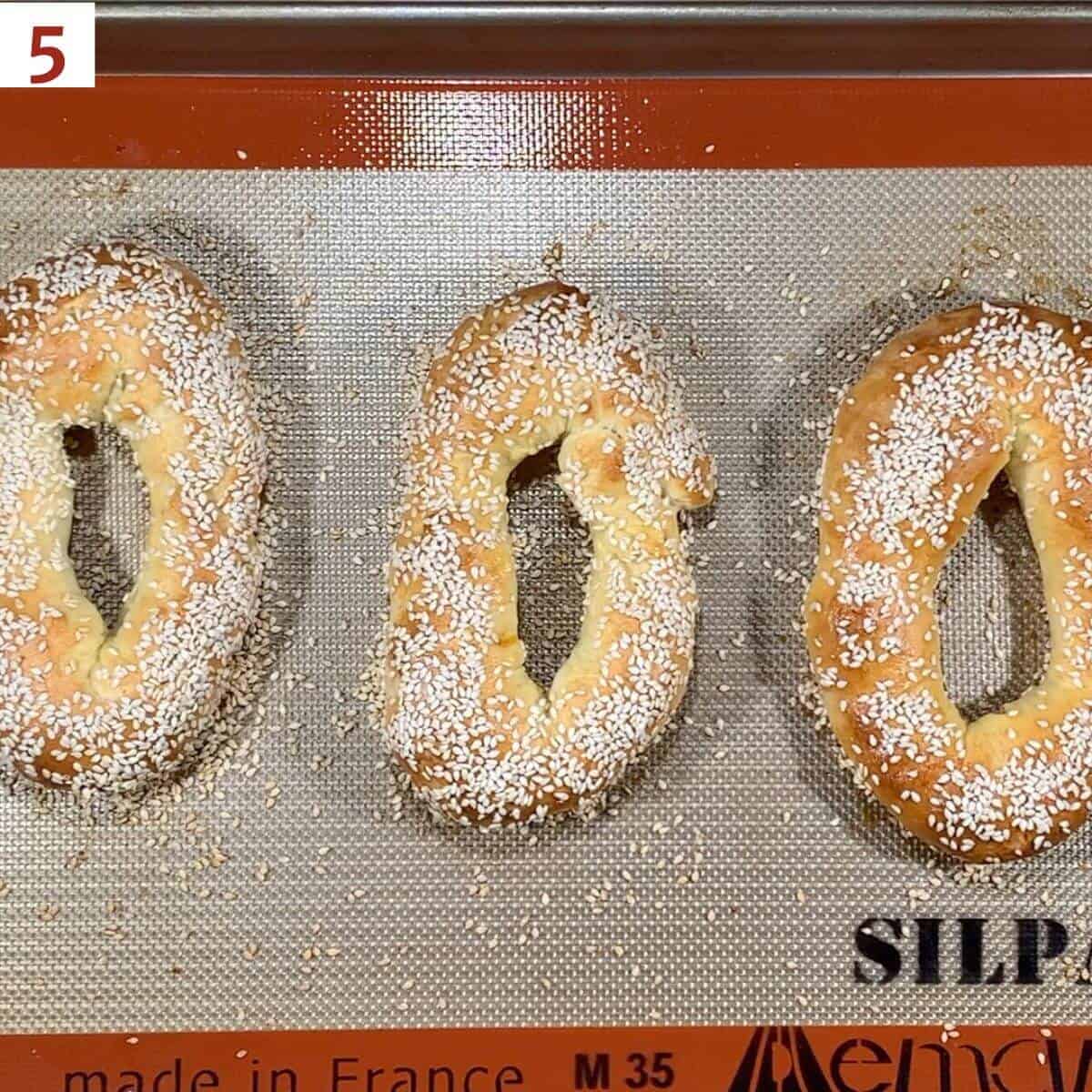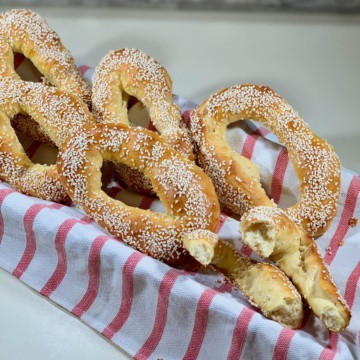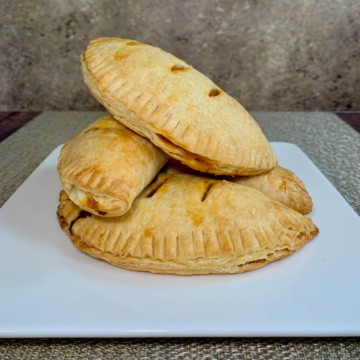Switch up your bagel game with these delicious soft and airy Sourdough Jerusalem Bagels. Slightly sweet and slightly tangy, these no boil bagels make a great breakfast or snack!

Jump to:
Why this recipe works
- No boil bagels - you just shape and bake
- Made with common pantry ingredients and unfed sourdough discard
- Slightly sweet, slightly tangy, and very snackable!
Jerusalem bagels (ka'ak Al-Quds in Arabic) are a Middle-Eastern staple - a long ring-shaped bread usually coated with sesame seeds. As the name implies, they're often found outside the gates of the Old City sold from pushcart vendors (that's where we discovered them on a long ago trip to Israel). As long as your arm, these oval, sesame-covered bagels are nothing like the traditional chewy bagels we're used to.
With my enduring search for sourdough discard uses, I decided to not only replicate those delicious Jerusalem bagels, but to adapt them to use my weekly unfed sourdough starter.
Sourdough Jerusalem Bagels are now a thing, and they're well worth making!
A no-boil bagel...who knew? Soft and airy Sourdough Jerusalem Bagels are delicious eaten with breakfast or as a snack. The sourdough discard lends a subtle tang to the subtly sweet dough, and the sesame adds a nutty texture.
Switch up your bagel game and bake a batch of slightly sweet and slightly tangy Sourdough Jerusalem bagels instead!
Recipe Ingredients
You'll need the following ingredients to make this sourdough Jerusalem bagel recipe:

Ingredient Notes
The ingredients for a Jerusalem bagel recipe are more similar to challah (minus the egg) than a classic bagel recipe: besides the flour, water, yeast, and salt, the recipe includes sugar and olive oil.
Sourdough starter discard: Sourdough discard is unfed sourdough starter, i.e. the amount you remove from your crock before feeding the remainder (I do this weekly). Since it's not active starter, it's used for flavor rather than fermentation (you'll need yeast for that).
Adding sourdough starter discard to my recipe for Jerusalem bagels adds an additional flavor dimension. Now you have a slightly sweet, slightly tangy, and slightly nutty Sourdough Jerusalem Bagel to snack on. Yummm...
Yeast: I use instant yeast in all my baking, but you can also use Active Dry yeast. If you use Active Dry yeast, then you might want to sprinkle yeast on to the warmed water with a teaspoon of sugar and allow it to sit for a few minutes before proceeding with the recipe. Letting it foam "proves" the yeast is active and ready to go to work.
If you'd like to omit the yeast and just use fed, active sourdough starter, see the instructions below.
Olive oil: Besides adding flavor, olive oil impedes the bagel dough's ability to rise, like in any enriched bread dough.
Milk powder: The addition of milk powder gives the bagel a softer texture. If you don't have dry milk powder, you can substitute ½ cup warmed milk and omit the water.
Topping: The outside of Jerusalem bagels are coated with an egg wash and topped with sesame seeds, just like challah. You can leave the sesame seeds plain, or mix them with sugar, a pinch of salt, or a bit of pomegranate molasses.
See the recipe card for a full list of ingredients and measurements.
How to leave out the commercial yeast
If you don't want to use commercial yeast in this sourdough Jerusalem bagels recipe, replace the yeast with ½ cup (114 grams) of active, fed starter, reduce the amount of flour by about ½ cup (57 grams), and reduce the milk by about ¼ cup (57 grams). The rising time will be longer (about double) for both the first and second rises. (Note: there are some rounding inconsistencies here due to the volume vs. weight measurement conversion.)
How to make sourdough Jerusalem bagels
Step 1: Make the dough
Stir together the flour, dry milk powder, sugar, yeast, and salt. Add the sourdough starter discard, ½ cup warm water, and the olive oil (photo 1). Mix on low speed for about a minute, then turn up the speed to medium and knead until the dough is smooth and elastic, about 6 to 8 minutes.
You can also mix and knead the dough in a bread machine (set to manual) or by hand.
Adjust the consistency of the dough as needed by adding more flour or water in 1 tablespoon increments. The amounts will be based on the humidity of the day. The dough is low in hydration, so it will be a little stiff.

Form the dough into a ball and place in an oiled bowl. Cover and set the bowl in a warm place for 60 to 90 minutes or until doubled in size (photo 2). The oven with just the light turned on works well.
You can also retard dough in the refrigerator overnight (and up to 2 days), both to let the dough develop more sourdough flavor, and if you’d rather have fresh bagels in the morning for breakfast. If you choose to chill the dough, let it come to room temperature on the counter for about an hour before continuing to shape the bagels.

Step 2: Shape the dough
Remove the dough to a lightly floured surface and press gently to deflate. Divide the dough into 6 equal-sized pieces, forming each one into a ball. Let the dough rest, covered with a towel, for a few minutes.
Here's another point where traditional bagels and Jerusalem bagels diverge: instead of just making the bagel round, you shape them into a long oval. This can be done in one of two ways:
- Form each dough portion into a ball. Press a finger through the middle of the ball of dough then slowly stretch the dough to make the hole larger (like when making regular bagels), until you get an oval about 8-inches in diameter (photo 3).
- Make a rope about 18-inches long (like when braiding challah), then join the ends and press them together. Hook a forefinger into the bottom of the hole that you just made, and gently stretch the dough to make a long hole.

Set the shaped bagels onto two half sheet baking pans lined with a Silpat silicone mat or parchment paper. Lightly brush each of the bagels with the egg wash using a pastry brush, then sprinkle liberally with the sesame seeds (photo 4).
Lightly cover and let rise for about 30 minutes until puffy to the touch (they won’t quite double in size but they will increase in volume).

Step 3: Bake the bagels
Like I mentioned earlier, this type of bagel does't require boiling, so you can skip directly to baking.
Bake at 375˚F for 18 to 22 minutes or until golden brown (photo 5). Rotate the trays back to front and exchanging top to bottom racks halfway through the baking time.

Storage instructions
The bagels are best eaten the day they are made. They'll keep for a few days at room temperature, but should be toasted or warmed in the oven before eating. They can also be frozen for up to two months.
What to serve with Jerusalem Bagels
Unlike the cream cheese shmear a normal bagel would get, Jerusalem Bagels are traditionally served with a side of za'atar, a sumac-based spice mix with other savory herbs and earthy spices. Sometimes they're dipped in hummus and tahini.
My husband likes his Sourdough Jerusalem Bagel plain and warmed a bit. And you know what? They're wonderful that way, too!
Questions asked and answered
Here are some questions you might have...
Jerusalem bagels are very similar to traditional bagels except in one important way - this is a no boil bagel dough. That is, the shaped bagels aren't boiled before baking.
When you boil bagel dough, the gluten firms up on the outside of the dough. Baking those boiled bagels tightens the outside even further, and that's how you get that distinctive bagel chewiness. It's the same with pretzels.
Since Jerusalem bagels aren't boiled, the outside stays soft, more like a roll than a bagel. And it simplifies the whole process considerably.
Even though we're skipping the boiling step to make Jerusalem Bagels, don't skip the egg wash. It gives the bagels a shiny exterior, and helps the sesame seeds stick.


More recipes featuring sourdough discard to try
Recipe

Sourdough Jerusalem Bagels (No Boil Bagels)
Equipment
Ingredients
For the bagels
- 2¾ cups all-purpose flour, or more as needed
- ¼ cup dry milk powder, see Recipe Notes
- 3 tablespoons granulated sugar
- 2½ teaspoons instant yeast, or Active Dry, see Recipe Notes
- 2 teaspoons kosher salt
- 1 cup sourdough starter discard, unfed, at room temperature
- ½ - ⅔ cup water, warmed between 100°F to 110°F, see Recipe Notes
- 1 tablespoon extra virgin olive oil
For the topping
- 1 large egg, beaten with 1 tablespoon water, for egg wash
- ½ cup sesame seeds, for topping
- za'atar seasoning mix, hummus, or tahini, for serving
Instructions
- Make the dough: In the bowl of a stand mixer fitted with a dough hook attachment, stir together the flour, dry milk powder, sugar, yeast, and salt.
- Add the sourdough starter discard, ½ cup (113 grams) warm water, and the olive oil. Mix on low speed for about a minute, then turn up the speed to medium and knead until the dough is smooth and elastic, about 6 to 8 minutes. You can also mix and knead the dough in a bread machine (set to manual) or by hand. Adjust the consistency of the dough as needed by adding more flour or water in 1 tablespoon increments. The amounts will be based on the humidity of the day. The dough is low in hydration, so it will be a little stiff.
- Form the dough into a ball and place in an oiled bowl. Cover and set the bowl in a warm place for 60 to 90 minutes or until doubled in size. The oven with just the light turned on works well.
- You can also retard dough in the refrigerator overnight (and up to 2 days), both to let the dough develop more sourdough flavor, and if you’d rather have fresh bagels in the morning for breakfast.Let the dough rise for at least 30 minutes before placing the bowl in the refrigerator. When you're ready to proceed, let the dough come to room temperature on the counter for about an hour before continuing to shape the bagels.
- Shape the dough: Remove the dough to a lightly floured surface and press gently to deflate. Divide the dough into 6 equal-sized pieces, forming each one into a ball. Let the dough rest, covered with a towel, for a few minutes.
- Shaping Method 1: Press a finger through the middle of each ball of dough then slowly stretch the dough to make the hole larger (like when making regular bagels), until you get an oval about 8-inches in diameter. Hook a forefinger into the bottom of the hole that you just made, and gently stretch the dough to make a long hole.
- Shaping Method 2: Make a rope about 18-inches long, then join the ends and press them together.
- Set the shaped bagels onto two half sheet baking pans lined with a Silpat silicone mat or parchment paper. Lightly brush each of the bagels with the egg wash using a pastry brush, then sprinkle liberally with the sesame seeds.
- Lightly cover and let rise for about 30 minutes until puffy to the touch (they won’t quite double in size but they will increase in volume). Meanwhile preheat the oven to 375 °F.
- Bake in the preheated oven for 18 to 22 minutes or until golden brown. Rotate the trays back to front and exchanging top to bottom racks halfway through the baking time.
- Remove the bagels from the oven and place on a wire rack to cool before serving.
- Serve with hummus, tahini, or za’atar seasoning mix. Or be like my husband and just eat them plain!
- Storage instructions: The bagels are best eaten the day they are made. They'll keep for a few days at room temperature, but should be toasted or warmed in the oven before eating. They can also be frozen for up to two months.













Debby says
These came out great but wanted to let you know there is no mention as to when to add the sourdough discard
I assumed with the milk and oil but you may want to update the recipe
Tammy Spencer says
Hi Debby, Good spot! You were right when to add in the starter, and I've updated the recipe to reflect that. Thanks for letting me know!